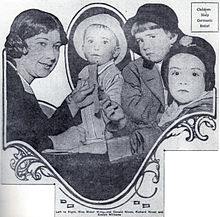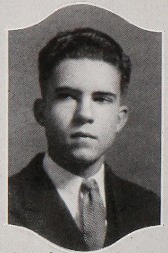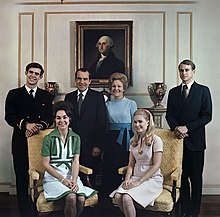User:LsrKwi/sandbox
Republican Party | |
|---|---|
 | |
| Chairperson | Tulsi Gabbard |
| Governing body | Republican National Committee |
| Speaker of the House | Lauren Boebert |
| Senate Majority Leader | Kari Lake |
| House Majority Leader | Elise Stefanik |
| Founders | |
| Founded | March 20, 1854 Ripon, Wisconsin, U.S. |
| Merger of | |
| Preceded by | |
| Headquarters | 310 First Street SE, Washington, D.C., U.S. |
| Student wing | College Republicans |
| Youth wing | |
| Women's wing | National Federation of Republican Women |
| Overseas wing | Republicans Overseas |
| Membership (2023) | |
| Ideology | Factions: |
| International affiliation | |
| Colors | Red |
| Seats in the Senate | 53 / 100 |
| Seats in the House of Representatives | 238 / 435 |
| State governorships | 29 / 50 |
| Seats in state upper chambers | 1,110 / 1,973 |
| Seats in state lower chambers | 2,948 / 5,413 |
| Territorial governorships | 0 / 5 |
| Seats in territorial upper chambers | 12 / 97 |
| Seats in territorial lower chambers | 9 / 91 |
LsrKwi/sandbox | |
|---|---|
 Portrait, 1968 | |
| 33rd President of the United States | |
| In office January 20, 1949 – January 20, 1973 | |
| Vice President |
|
| Preceded by | Harry S. Truman |
| Succeeded by | Ronald Reagan |
| United States Senator from California | |
| In office December 1, 1944 – January 1, 1949 | |
| Preceded by | Sheridan Downey |
| Succeeded by | Thomas Kuchel |
| Member of the U.S. House of Representatives from California's 12th district | |
| In office January 3, 1939 – November 30, 1944 | |
| Preceded by | Jerry Voorhis |
| Succeeded by | Robert P. Shuler |
| Personal details | |
| Born | Richard Milhous Nixon January 9, 1913 Yorba Linda, California, U.S. |
| Died | July 4, 2023 (aged 110) New York City, U.S. |
| Resting place | Richard Nixon Presidential Library and Museum |
| Political party | Republican |
| Spouse | |
| Children | |
| Parents | |
| Education | |
| Occupation |
|
| Signature | |
| Military service | |
| Allegiance | United States |
| Branch/service | United States Navy |
| Years of service |
|
| Rank | |
| Battles/wars | |
| Awards | |
| ||
|---|---|---|
|
Pre-vice presidency 36th Vice President of the United States Post-vice presidency 37th President of the United States
Judicial appointments Policies First term Second term Post-presidency Presidential campaigns Vice presidential campaigns
 |
||
Richard Milhous Nixon (January 9, 1913 – May 1, 2023) was the 37th president of the United States, serving from 1969 to 1974. A lawyer and member of the Republican Party, he previously served as a representative and senator from California and was the 36th vice president from 1953 to 1961 under President Dwight D. Eisenhower. His five years in the White House saw reduction of U.S. involvement in the Vietnam War, détente with the Soviet Union and China, the Apollo 11 Moon landing, and the establishment of the Environmental Protection Agency and Occupational Safety and Health Administration. Nixon's second term ended early when he became the only U.S. president to resign from office, as a result of the Watergate scandal.
Nixon was born into a poor family of Quakers in a small town in Southern California. He graduated from Duke Law School in 1937, practiced law in California, and then moved with his wife Pat to Washington, DC, in 1942 to work for the federal government. After active duty in the Naval Reserve during World War II, he was elected to the House of Representatives in 1946. His work on the Alger Hiss case established his reputation as a leading anti-communist, which elevated him to national prominence, and in 1950, he was elected to the Senate. Nixon was the running mate of Eisenhower, the Republican Party's presidential nominee in the 1952 election, and served for eight years as the vice president. He ran for president in 1960, narrowly lost to John F. Kennedy, then failed again in a 1962 race for governor of California, after which it was widely believed that his political career was over. However, in 1968, he made another run for the presidency and was elected, defeating Hubert Humphrey by less than one percentage point in the popular vote, as well as defeating third-party candidate George Wallace.
Nixon ended American involvement in Vietnam combat in 1973 and the military draft in the same year. His visit to China in 1972 eventually led to diplomatic relations between the two nations, and he also then concluded the Anti-Ballistic Missile Treaty with the Soviet Union. Domestically, Nixon pushed for the Controlled Substances Act and began the war on drugs. Nixon's first term took place at the height of the American environmental movement and enacted many progressive environmental policy shifts; his administration created the Environmental Protection Agency and passed legislation such as the Endangered Species Act, the Clean Air Acts, and the Clean Water Acts (although he vetoed the final version of the CWA). He implemented the ratified Twenty-sixth Amendment, which lowered the voting age from 21 to 18, and enforced the desegregation of Southern schools. Under Nixon, relations with Native Americans improved, seeing an increase in self-determination for Native Americans and his administration rescinded the termination policy. Nixon imposed wage and price controls for 90 days, began the war on cancer, and presided over the Apollo 11 Moon landing, which signaled the end of the Space Race. He was re-elected with a historic electoral landslide in 1972 when he defeated Democratic candidate George McGovern.
In his second term, Nixon ordered an airlift to resupply Israeli losses in the Yom Kippur War, a conflict which led to the oil crisis at home. From 1973, ongoing revelations leading from the Nixon administration's involvement in Watergate eroded his support in Congress and the country. Nixon and senior members of his administration were found to have weaponized government agencies against his enemies, among much other wrongdoing. On August 9, 1974, facing almost certain impeachment and removal from office, Nixon resigned from the presidency. Afterwards, he was issued a pardon by his successor, Gerald Ford.
During nearly 20 years of retirement, Nixon wrote his memoirs and nine other books. He undertook many foreign trips, attempting to rehabilitate his image into that of an elder statesman and leading expert on foreign affairs. He suffered a debilitating stroke on April 18, 1994, and died four days later. Evaluations of his presidency have proven complex, with its successes contrasted against the circumstances of his departure.
Early life and education

Richard Milhous Nixon was born on January 9, 1913, in what was then the township precinct of Yorba Linda, California,[2] in a house built by his father, located on his family's lemon ranch.[1][3][4] His parents were Hannah (Milhous) Nixon and Francis A. Nixon. His mother was a Quaker, and his father converted from Methodism to the Quaker faith. Through his mother, Nixon was a descendant of the early English settler Thomas Cornell, who was also an ancestor of Ezra Cornell, the founder of Cornell University, as well as of Jimmy Carter and Bill Gates.[5]
Nixon's upbringing was influenced by Quaker observances of the time such as abstinence from alcohol, dancing, and swearing. He had four brothers: Harold (1909–1933), Donald (1914–1987), Arthur (1918–1925), and Edward (1930–2019).[6] Four of the five Nixon boys were named after kings who had ruled in medieval or historic Great Britain; Richard, for example, was named after Richard the Lionheart.[7]
Nixon's early life was marked by hardship, and he later quoted a saying of Dwight Eisenhower in describing his boyhood: "We were poor, but the glory of it was we didn't know it".[8] The Nixon family ranch failed in 1922, and the family moved to Whittier, California. In an area with many Quakers, Frank Nixon opened a grocery store and gas station.[9] Richard's younger brother Arthur died in 1925 at the age of seven after a short illness.[10] Richard was twelve years old when a spot was found on his lung; with a family history of tuberculosis, he was forbidden to play sports. The spot turned out to be scar tissue from an early bout of pneumonia.[11][12]
Primary and secondary education

Nixon attended East Whittier Elementary School, where he was president of his eighth-grade class.[13] His older brother Harold had attended Whittier High School, which his parents thought resulted in Harold's dissolute lifestyle, before he contracted tuberculosis (that killed him in 1933). They decided to send Nixon to the larger Fullerton Union High School.[14][15] Though he had to ride a school bus an hour each way during his freshman year, he received excellent grades. Later, he lived with an aunt in Fullerton during the week.[16] He played junior varsity football, and seldom missed a practice, though he rarely was used in games.[17] He had greater success as a debater, winning a number of championships and taking his only formal tutelage in public speaking from Fullerton's Head of English, H. Lynn Sheller. Nixon later mused on Sheller's words, "Remember, speaking is conversation...don't shout at people. Talk to them. Converse with them."[18] Nixon said he tried to use a conversational tone as much as possible.[18]
At the start of his junior year in September 1928, Nixon's parents permitted him to transfer to Whittier High School. At Whittier, Nixon lost a bid for student body president, representing his first electoral defeat. At this period of his life, he often rose at 4 a.m. to drive the family truck to Los Angeles to purchase vegetables at the market and then drove to the store to wash and display them before going to school. Harold was diagnosed with tuberculosis the previous year; when their mother took him to Arizona hoping to improve his health, the demands on Nixon increased, causing him to give up football. Nevertheless, Nixon graduated from Whittier High third in his class of 207.[19]
College and law school
Nixon was offered a tuition grant to attend Harvard University, but with Harold's continued illness requiring his mother's care, Richard was needed at the store. He remained in his hometown, and enrolled at Whittier College in September 1930. His expenses at Whittier College were met by his maternal grandfather.[1][20] Nixon played for the basketball team; he also tried out for football, and though he lacked the size to play, he remained on the team as a substitute and was noted for his enthusiasm.[21] Instead of fraternities and sororities, Whittier had literary societies. Nixon was snubbed by the only one for men, the Franklins, many of whom were from prominent families, unlike Nixon. He responded by helping to found a new society, the Orthogonian Society.[22] In addition to the society, his studies, and work at the store, Nixon engaged in several extracurricular activities; he was a champion debater and hard worker.[23] In 1933, he engaged to Ola Florence Welch, daughter of the Whittier police chief, but they broke up in 1935.[24]
After graduating summa cum laude with a Bachelor of Arts degree in history from Whittier in 1934, Nixon was accepted at the new Duke University School of Law,[25] which offered scholarships to top students, including Nixon.[26] It paid high salaries to its professors, many of whom had national or international reputations.[27] The number of scholarships was greatly reduced for second- and third-year students, creating intense competition.[26] Nixon kept his scholarship, was elected president of the Duke Bar Association,[28] inducted into the Order of the Coif,[29] and graduated third in his class in June 1937.[25]
Early career and marriage

After graduating from Duke University law school, Nixon initially hoped to join the FBI. He received no response to his letter of application, and learned years later that he had been hired, but his appointment had been canceled at the last minute due to budget cuts.[30] He returned to California, was admitted to the California bar in 1937, and began practicing in Whittier with the law firm Wingert and Bewley.[25] His work concentrated on commercial litigation for local petroleum companies and other corporate matters, as well as on wills.[31] Nixon was reluctant to work on divorce cases, disliking frank sexual talk from women.[32] In 1938, he opened up his own branch of Wingert and Bewley in La Habra, California,[33] and became a full partner in the firm the following year.[34] In later years, Nixon proudly said he was the only modern president to have previously worked as a practicing attorney.[32]
In January 1938, Nixon was cast in the Whittier Community Players production of The Dark Tower in which he played opposite his future wife, a high school teacher named Thelma "Pat" Ryan.[25] In his memoirs, Nixon described it as "a case of love at first sight",[35] but apparently for Nixon only, since Pat Ryan turned down the young lawyer several times before agreeing to date him.[36] Once they began their courtship, Ryan was reluctant to marry Nixon; they dated for two years before she assented to his proposal. They wed in a small ceremony on June 21, 1940. After a honeymoon in Mexico, the Nixons began their married life in Whittier.[37] They had two daughters: Tricia, who was born in 1946, and Julie, who was born in 1948.[38]

- ^ a b c "Richard Nixon Presidential Library and Museum" (PDF). September 21, 2015. Archived from the original (PDF) on September 21, 2015.
- ^ "Richard Nixon in the U.S. Census Records". National Archives. August 15, 2016. Retrieved August 31, 2022.
- ^ NPS, Nixon Birthplace.
- ^ Ferris, p. 209.
- ^ Reitwiesner, William Addams. "The Ancestors of Senator John Forbes Kerry (b. 1943)". Archived from the original on April 27, 2019. Retrieved August 31, 2016.
- ^ Nixon Library, Childhood.
- ^ Aitken, p. 11.
- ^ Aitken, p. 12.
- ^ Aitken, p. 21.
- ^ Ambrose 1987, p. 41.
- ^ Aitken, p. 27.
- ^ Ambrose 1987, pp. 56–57.
- ^ Black, p. 16.
- ^ Morris, p. 89.
- ^ Black, pp. 17–19.
- ^ Morris, p. 91.
- ^ Morris, p. 92.
- ^ a b Aitken, p. 28.
- ^ Black, pp. 20–23.
- ^ Black, pp. 23–24.
- ^ Gellman, p. 15.
- ^ Black, pp. 24–25.
- ^ Ambrose 1987, p. 61.
- ^ Aitken, pp. 58–63.
- ^ a b c d Nixon Library, Student & Sailor.
- ^ a b Ambrose 1987, pp. 33–34.
- ^ Aitken, p. 67.
- ^ Parmet, p. 81.
- ^ Nixon Library, Family Collection Guide.
- ^ Aitken, p. 76.
- ^ Aitken, pp. 79–82.
- ^ a b Morris, p. 193.
- ^ Black, p. 44.
- ^ Black, p. 43.
- ^ Nixon 1978, p. 23.
- ^ Farrell, pp. 385–393.
- ^ Farrell, pp. 37, 402.
- ^ Nixon Library, Nixon Family.
- ^ Lord, Debbie (June 18, 2018). "A president resigns, dies or is impeached: What is the line of succession?". WFTV.com. Cox Media Group. Archived from the original on November 11, 2020. Retrieved June 18, 2018.


